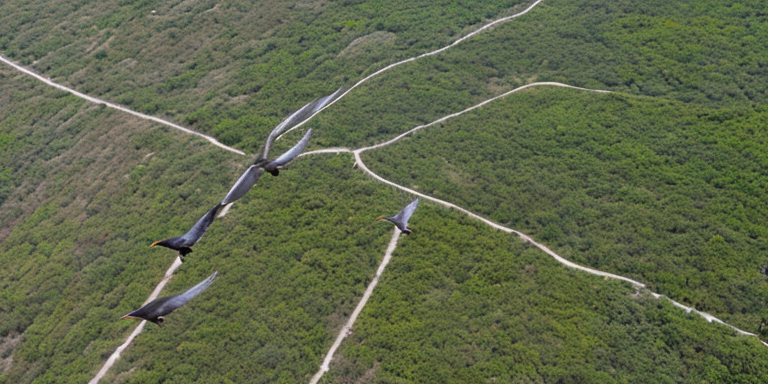The Wonders of Bird Migration
Bird migration is one of the most remarkable phenomena in the animal kingdom. Every year, millions of birds travel thousands of miles across continents and oceans to breed, feed, and survive. These journeys are often perilous, with birds facing numerous challenges, such as predators, weather, and human activities. However, bird migration is also essential for maintaining ecological balance and biodiversity. Without it, many plant and animal species would be at risk of extinction.
The study of bird migration is crucial for understanding the patterns, mechanisms, and consequences of this phenomenon. Researchers have been studying bird migration for centuries, using various methods such as banding, tracking, and observation. One recent study has shed new light on the effects of climate change on bird migration, revealing the potential risks and opportunities for conservation.
The study’s purpose was to investigate the impact of climate change on bird migration and the implications for wildlife conservation. The researchers used a combination of field observations, satellite tracking, and climate modeling to analyze the patterns and timing of bird migration in North America. They focused on 48 bird species that migrate between their breeding and wintering grounds in the US and Canada.
The study’s significance lies in its contribution to our understanding of the complex interactions between climate change and wildlife. By examining the effects of altered weather patterns on bird migration, the researchers were able to identify potential risks and opportunities for conservation. They found that climate change could affect the timing, duration, and routes of bird migration, as well as the availability of food and habitat along the way. These changes could have negative impacts on bird survival, behavior, and population dynamics.
However, the study also revealed some possible solutions for mitigating the effects of climate change on bird migration. These include the creation of habitat corridors to maintain migration pathways, the planting of native vegetation to provide food and shelter, and the reduction of human activities that disrupt bird migration. By implementing these measures, we can help ensure the survival and well-being of migratory birds and the ecosystems they inhabit.
In the next section, we will delve into the study’s background, including its methodology and data collection. By understanding how the study was conducted, we can better appreciate its findings and implications for environmental conservation.
The Effects of Climate Change on Bird Migration
Bird migration is a natural phenomenon that has fascinated scientists and bird enthusiasts for centuries. However, with the onset of climate change, bird migration patterns have been significantly altered, leading to negative impacts on bird survival and changes in behavior and habitat.
The study’s methodology involved years of observations and data collection, with researchers like Uvanni playing a significant role in the process. Through this research, it has become evident that altered weather patterns have a significant impact on bird migration. Birds rely on environmental cues, such as temperature changes and the availability of food, to determine when and where to migrate.
However, with climate change, these cues are becoming less reliable, leading to a delay or even a complete disruption of migration patterns. This can have severe consequences for bird survival, as they may arrive at their breeding grounds too late to successfully reproduce or may not have access to food sources along their migration route.
Furthermore, climate change is also leading to changes in bird behavior and habitat. Some bird species are now migrating to new areas, while others are staying in their breeding grounds for longer periods. This can lead to overcrowding and competition for resources, which can negatively impact bird populations.
To mitigate these effects, possible solutions include the creation of habitat corridors to maintain migration pathways and the planting of native vegetation to provide food sources for birds. These solutions can help ensure that bird populations can continue to migrate and thrive despite the impacts of climate change.
In conclusion, the effects of climate change on bird migration are significant and have far-reaching consequences for bird survival and behavior. It is essential to continue researching the impacts of climate change on wildlife and to implement solutions to mitigate these effects. By doing so, we can ensure that future generations can continue to enjoy the beauty and wonder of bird migration.
Climate Change and Migration: How Altered Weather Patterns Affect Bird Survival
Bird migration is a natural phenomenon that has fascinated humans for centuries. Every year, millions of birds travel thousands of miles to reach their breeding and wintering grounds. However, climate change is altering the timing and patterns of bird migration, affecting their survival and behavior.
The study conducted by Uvanni and his team aimed to understand the impact of climate change on bird migration. Using years of observations and data collected through bird banding, the researchers found that altered weather patterns affect the cues that birds use to time their migration. This can lead to birds arriving too early or too late at their breeding or wintering grounds, affecting their ability to find food and mates.
Environmental cues, such as changes in day length, temperature, and food availability, play a crucial role in bird migration. Birds rely on these cues to time their migration and navigate their way across long distances. However, climate change is disrupting these cues, making it harder for birds to time their migration accurately.
The negative impact of climate change on bird survival is evident in the declining populations of many bird species. Changes in weather patterns and habitat loss are making it harder for birds to find food and shelter, leading to decreased reproductive success and survival rates.
In addition to affecting bird survival, climate change is also changing bird behavior and habitat. For example, some bird species are shifting their breeding ranges northward in response to warming temperatures, while others are altering their feeding habits to adapt to changes in food availability.
To mitigate the effects of climate change on bird migration, conservationists are exploring possible solutions such as habitat corridors and the planting of native vegetation. Habitat corridors can help maintain migration pathways and provide birds with suitable habitat along their journey. Planting native vegetation can also provide birds with food and shelter, helping them survive and adapt to changing environments.
In conclusion, climate change is altering bird migration patterns and affecting their survival and behavior. The study conducted by Uvanni and his team highlights the importance of understanding the impact of climate change on wildlife and the need for conservation efforts to mitigate its effects. By implementing solutions such as habitat corridors and planting native vegetation, we can help protect birds and other wildlife from the negative effects of climate change.
The Devastating Effects of Climate Change on Birds
As climate change continues to alter weather patterns and disrupt ecosystems, birds are facing significant challenges in their migration and survival. The negative impact of climate change on birds is becoming increasingly evident, with changes in behavior and habitat that threaten their existence.
One of the most significant effects of climate change on birds is the disruption of their migration patterns. Environmental cues, such as changes in temperature and daylight hours, trigger birds to migrate to different locations. However, with climate change causing erratic weather patterns, these cues are becoming less reliable, causing confusion and disorientation for birds.
As a result, many birds are arriving at their breeding grounds too early or too late, missing the optimal conditions for nesting and feeding. This can lead to a decline in population and a reduction in genetic diversity, which can have long-term consequences for the species.
Climate change is also causing changes in bird behavior and habitat. For example, some bird species are shifting their ranges northward, seeking cooler temperatures and more suitable habitats. This can lead to competition for resources with other bird species and can disrupt the balance of ecosystems.
Additionally, changes in precipitation patterns can affect the availability of food and water for birds, leading to malnutrition and dehydration. This can weaken birds and make them more susceptible to disease and predation.
Despite the challenges that climate change poses for birds, there are potential solutions to mitigate its effects. One such solution is the creation of habitat corridors, which provide a continuous pathway for birds to migrate and access suitable habitats. These corridors can be created by restoring degraded habitats and connecting fragmented landscapes.
Planting native vegetation is another solution that can help birds adapt to changing conditions. Native plants provide food and shelter for birds and can help maintain the balance of ecosystems. By planting native vegetation, we can create more resilient habitats that can support bird populations in the face of climate change.
In conclusion, the negative impact of climate change on birds is becoming increasingly evident, with changes in behavior and habitat that threaten their existence. However, there are potential solutions to mitigate these effects, such as habitat corridors and planting native vegetation. By taking action to protect bird populations, we can help ensure the survival of these important species and maintain the balance of ecosystems.
Creating Sustainable Solutions for Bird Migration
As we have seen in the previous sections, climate change has had a significant impact on bird migration, affecting everything from the timing of migration to the survival of bird populations. While the problem may seem daunting, there are steps we can take to help mitigate the negative effects of climate change on bird migration.
One solution is the creation of habitat corridors. These corridors are areas of land that connect habitats, allowing birds to travel along their migration pathways without interruption. By maintaining these pathways, we can help ensure that birds can continue to migrate and breed successfully. Habitat corridors can be created by setting aside land for conservation, restoring degraded habitats, and protecting existing habitats from development.
Another solution is the planting of native vegetation. Native plants provide birds with food and shelter, and they are often better adapted to local weather conditions than non-native plants. By planting native vegetation in our yards and public spaces, we can create a network of habitats that support bird populations throughout their migration.
Legislation and policy also play a crucial role in protecting bird habitats and migration pathways. Judges have the power to interpret and enforce laws that protect wildlife and their habitats. By supporting legislation that protects bird habitats and migration pathways, we can ensure that these areas are preserved for future generations.
Individual actions can also make a difference. By reducing our carbon footprint, we can help slow the rate of climate change and reduce its impact on bird migration. Simple actions like turning off lights when not in use, using public transportation, and reducing meat consumption can all help reduce our carbon footprint.
In conclusion, the negative effects of climate change on bird migration are a significant problem, but there are steps we can take to help mitigate these effects. By creating habitat corridors, planting native vegetation, supporting legislation that protects bird habitats, and reducing our carbon footprint, we can help ensure that birds can continue to migrate and breed successfully. It is up to us to take action and make changes to protect our environment.
The Power of Individual Actions
As we have seen in the previous sections, climate change has a significant impact on bird migration. While habitat corridors and planting native vegetation are essential steps in preserving migration pathways, individual actions can also make a difference.
One of the most significant contributors to climate change is the burning of fossil fuels. By reducing our carbon footprint, we can help mitigate the effects of climate change on bird migration. Here are some simple steps we can take:
-
Reduce energy consumption: Turn off lights and unplug appliances when not in use. Use energy-efficient light bulbs and appliances.
-
Use public transportation, carpool, or walk/bike instead of driving alone.
-
Eat a plant-based diet or reduce meat consumption: Animal agriculture is a significant contributor to greenhouse gas emissions.
-
Reduce waste: Recycle, compost, and avoid single-use plastics.
-
Support renewable energy: Choose energy providers that use renewable energy sources.
While individual actions are essential, collective efforts are also necessary to preserve the environment for future generations. Governments, businesses, and communities must work together to reduce greenhouse gas emissions and protect wildlife habitats.
In conclusion, the study’s findings highlight the importance of preserving bird migration pathways in the face of climate change. While habitat corridors and planting native vegetation are crucial steps, individual actions can also make a difference. By reducing our carbon footprint and supporting collective efforts to protect the environment, we can help ensure a sustainable future for wildlife and humans alike.









